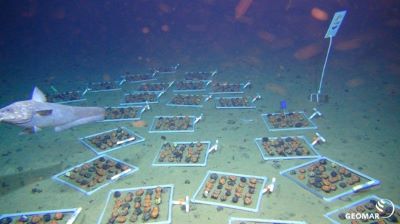Context:
An unknown process is producing oxygen deep in the world’s oceans, where it is too dark for photosynthesis, scientists reported on July 22 in the journal Nature Geoscience, could have significant implications for deep-sea mining activities, particularly concerning polymetallic nodules.
Deep-Sea Mining
Deep-sea mining is anticipated to become a significant marine resource extraction activity in the coming decades. It involves extracting mineral deposits from the ocean floor below 200 meters. As terrestrial mineral resources become depleted and demand for metals rises, deep-sea mining is expected to become a significant activity. However, research suggests that such mining could lead to the destruction of habitats and the extinction of species.
The International Seabed Authority has granted several 15-year contracts, including to the Government of India, for exploring and mining polymetallic nodules and other resources in the deep seabed. Polymetallic nodules are rich in iron, manganese, and other metals, making them valuable for future mining endeavours.
Significance of Deep-Sea Mining
Interest in seabed mineral deposits is increasing due to the depletion of terrestrial sources and the rising demand for metals like copper, nickel, aluminum, manganese, zinc, lithium, and cobalt. These metals are essential for manufacturing technologies such as smartphones, wind turbines, solar panels, and batteries. Deep-sea mining presents a promising source of these critical minerals, potentially enabling advancements in technologies like extended-range electric vehicles, lighter rechargeable batteries, and more durable wind turbines
Oxygen Concentration
The study, conducted by scientists from Germany, the U.K., and the U.S., focused on the Clarion-Clipperton Zone, located off Mexico’s west coast. This area, larger than India, is known for its high concentration of polymetallic nodules. During their research, scientists observed an unexpected increase in oxygen concentration at depths of 4 km, where photosynthesis is not possible. This finding led to the hypothesis that polymetallic nodules could be generating oxygen through a previously unknown process involving electrical charges.
Mech anism of Oxygen Generation
The researchers discovered that the surfaces of polymetallic nodules have a voltage of up to 0.95 volts. This voltage, though less than the 1.5 volts needed to split water molecules directly, could build up if numerous nodules are close together, functioning similarly to a battery. This mechanism might account for the observed increase in oxygen levels in the abyssal zone.
Implications for Deep-Sea Mining
Current Challenges and Considerations
The discovery of ‘dark oxygen’ has raised concerns about the potential impact of deep-sea mining on marine ecosystems. The Clarion-Clipperton Zone is one of the world's largest reserves of polymetallic nodules, but the process of mining these resources may disrupt the delicate balance of oxygen levels that sustain deep-sea life. Previous studies, such as the Disturbance and Recolonisation (DISCOL) Experiment, have shown that mining activities can have long-lasting adverse effects on deep-sea ecosystems. For instance, the DISCOL experiment revealed enduring impacts on the megabenthos of the Peru Basin, even 26 years after disturbances.
The potential harm of deep-sea mining to marine ecosystems has prompted concerns from environmental experts and insurance companies. In November 2023, major European insurance firms announced they would exclude deep-sea mining from their underwriting portfolios due to the risks involved. The additional complexity of ‘dark oxygen’ only heightens the challenge of conducting sustainable deep-sea mining.
Other Concerns Related to Deep-Sea Mining
● Lack of Comprehensive Knowledge: The deep sea remains largely unexplored and poorly understood, leaving significant gaps in our knowledge of its biodiversity and ecosystems. This lack of information hampers efforts to implement adequate safeguards for the marine environment and the three billion people who rely on marine and coastal resources for their livelihoods.
● Sediment Plumes: Mining operations stir up fine sediments on the seafloor, creating plumes of suspended particles that can disperse over long distances. Additionally, mining ships often discharge wastewater at the surface, further exacerbating the problem. For instance, the particles can smother marine life, damage filter-feeding organisms, and interfere with visual communication among deep-sea animals.
● Pollution: Deep-sea mining operations can also introduce pollution into the marine environment. Noise, vibrations, and light pollution from mining equipment and surface vessels can affect species such as whales, tuna, and sharks. Moreover, potential leaks and spills of fuel and toxic substances can further contaminate the marine environment, posing additional risks to marine life.
● Addressing Challenges: Deep-sea mining presents challenges such as environmental impacts and the need for advanced technology and regulatory measures.
● Sustainability and Responsibility: It is crucial to conduct deep-sea mining in a sustainable and responsible manner to minimize negative effects on marine ecosystems and ensure the long-term availability of these resources.
● National Centre for Polar and Ocean Research (NCPOR): Established in 2020 by the Ministry of Earth Sciences in Goa to explore India’s deep-sea mineral resources, NCPOR will play a key role in advancing deep-sea research and resource management.
● Draft Deep Seabed Mining Regulations, 2021: The Indian government has formulated these regulations to create a legal framework for the exploration and exploitation of mineral resources within the country’s exclusive economic zone (EEZ), ensuring structured and regulated deep-sea mining activities.
The discovery of ‘dark oxygen’ underscores the need for a thorough understanding of deep-sea ecosystems before proceeding with extensive mining activities. As the potential for damage to these unique environments grows, it is crucial to explore sustainable practices and consider the broader ecological impacts of deep-sea resource extraction.
|
Probable Questions for UPSC Mains 1. Discuss the implications of the recent discovery of 'dark oxygen' in the Clarion-Clipperton Zone on the future of deep-sea mining activities. How might this discovery impact environmental regulations and sustainability measures in deep-sea resource extraction? (10 Marks, 150 Words) 2. Evaluate the current regulatory framework governing deep-sea mining under the United Nations Convention on the Law of the Sea (UNCLOS). How effective is this framework in ensuring the sustainable and responsible exploitation of deep-sea mineral resources, and what improvements could be made to address the challenges identified in recent studies? (15 Marks, 250 Words) |
Source: The Hindu









